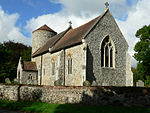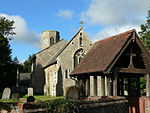Shotesham
AC with 0 elementsCivil parishes in NorfolkShoteshamVillages in Norfolk

Shotesham () is a village in South Norfolk which lies approximately 5 miles south of Norwich. It sits next to Stoke Holy Cross and Saxlingham Nethergate in the valley of the River Tas. It covers an area of 14.50 km2 (5.60 sq mi) and had a population of 539 in 210 households at the 2001 census, increasing to 562 in 227 households at the 2011 census.Shotesham was for many years the Norfolk seat of the D'Oyly family and of the D'Oyly baronets 'of Shottisham', Norfolk (not to be confused with Shottisham, Suffolk), who also possessed estates in Suffolk. The country house and estate of Shotesham Park, designed by Sir John Soane is the seat of the Fellowes family.
Excerpt from the Wikipedia article Shotesham (License: CC BY-SA 3.0, Authors, Images).Shotesham
Chapel Lane, South Norfolk
Geographical coordinates (GPS) Address Website Nearby Places Show on map
Geographical coordinates (GPS)
| Latitude | Longitude |
|---|---|
| N 52.543686 ° | E 1.321621 ° |
Address
R B Copping
Chapel Lane
NR15 1YP South Norfolk
England, United Kingdom
Open on Google Maps










